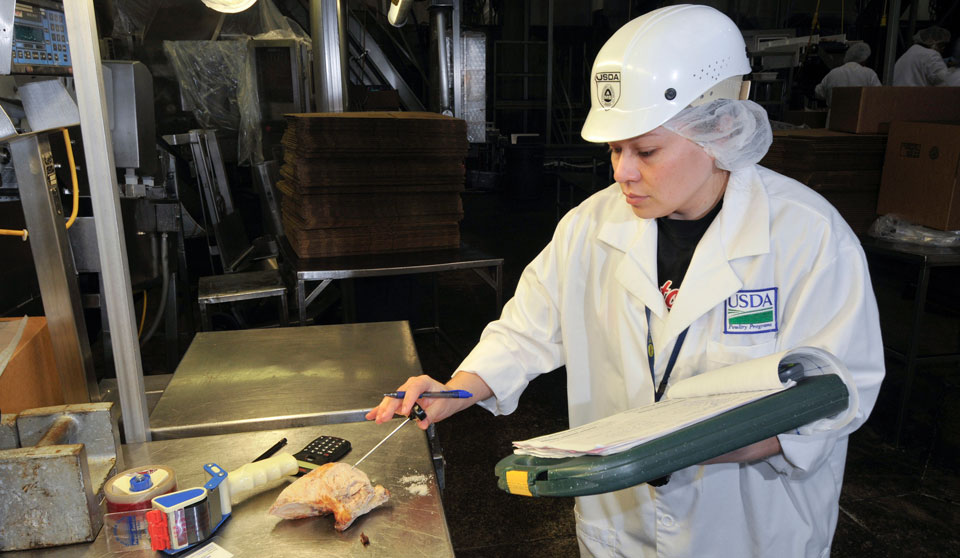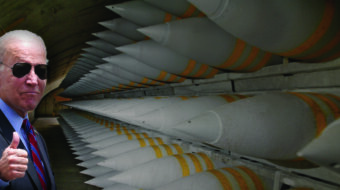
WASHINGTON—Four years ago, at the behest of the nation’s big poultry processors, the Obama administration’s Agriculture Department planned to speed up poultry plant production lines, endangering 250,000 workers and potentially putting sick chickens on consumers’ plates. It lost. Now the Trump government is trying again.
Protests, including an informational picket line in front of USDA headquarters in D.C., and a lawsuit by the Government Employees (AFGE), which represents poultry inspectors – whom that rule would also have replaced in many cases with plant supervisors – brought that speedup scheme to a screeching halt.
But at least Obama put the idea out for consumers and workers to protest. On October 4, GOP President Donald Trump’s USDA did virtually the same thing, the National Employment Law Project reports – but without telling anyone. Instead, it started exempting individual poultry plants from the rule, thorough USDA waivers.
NELP, whose attorneys defend the exploited poultry processing workers – many of them foreign-born, more than half of them women, and many of them minorities — noticed. So did the labor-backed National Consumers League. Its executive director, Sally Greenberg, states her organization will do all it can to prevent sick chickens (and turkeys) from showing up on consumers’ plates.
“We opposed this four years ago, and we’ll do everything we can to oppose it again,” she says.
Poultry processing is one of the most hazardous jobs in the U.S. Injuries are common. Workers suffer either repetitive-motion (ergonomic) ills from having to perform the same job and use the same tired muscles over and over or, worse, they get a finger or a hand or a foot caught in a processing machine after slipping on the bloody floors of processing plants. Amputations abound. Toxic chemicals do, too.
That doesn’t stop the poultry plants from trying to speed up the processing lines, which now go at least 40 birds a minute. The more bird carcasses go through every minute, the more the processors can ship out the door – and the more money plant bosses make, even when the plants are unionized. But most poultry-processing factories, quartered in the notoriously union-hating South, aren’t.
The result of the waivers, predicts Greenberg: Injured workers and chickens that go by so fast the inspectors can’t catch – and discard – all the diseased birds.
“The National Consumers League has always opposed speeding up the poultry factory lines,” Greenberg said in a telephone interview. “It puts the workers in danger and it’ll cause more worker injuries.”
“And the faster the lines go, the more mistakes there are on the factory floor,” including more missed sick chickens, Greenberg points out. “There’s a direct link between line speeds and food-borne illness” caused by the presence of harmful bacteria on or in poultry carcasses. “Safety for consumers” and workers “gets short shrift when those lines move more quickly.”
NELP Worker Safety And Health Director Debbie Berkowitz, a former senior Occupational Safety and Health Administration official, blew the whistle on the Trump USDA scheme.
Trump’s USDA “declared it will start a new program to allow chicken plants to increase their line speeds, despite increasing evidence this will endanger vulnerable workers, public health, and animal welfare,” Berkowitz said. She called USDA’s statement “stunning.”
“USDA already studied whether to increase poultry line speeds, and it adopted a rule in 2014, with enormous public input, that rejected any line speed increases in order to best protect public and worker health,” she explained, referring to the Obama USDA’s battle with AFGE, NCL and others over the prior line speed-up plan.
“Yet, with no additional evidence or data provided, the administration has now decided to bend all the rules to benefit rich corporations at the expense of the well-being and safety of workers and consumers.” It’s doing so by giving out the waivers from its rules, Berkowitz elaborated.
“Poultry workers suffer staggeringly high rates of work-related injury and illnesses — rates 60 percent higher than the average worker,” she noted. She told Congress four years ago the two biggest poultry processing conglomerates, Tyson Foods and JBS, are fourth and seventh nationwide among all factories, enterprises and firms, in amputations and hospitalizations of workers for on-the-job injuries. The processors also are extremely profitable, controlling everything from the poultry farms on up.
“Overwhelming evidence supports the conclusion that allowing poultry processing plants to operate with faster line speeds than allowable by law is inconsistent with the USDA’s waiver regulation, undermines the rule,” breaks the federal law that requires public notice and comment on such actions, “and most of all, endangers both workers and consumers,” Berkowitz said of the Trump administration’s waiver scheme.
Like free stuff? So do we. Here at People’s World, we believe strongly in the mission of keeping the labor and democratic movements informed so they are prepared for the struggle. But we need your help. While our content is free for readers (something we are proud of) it takes money — a lot of it — to produce and cover the stories you see in our pages. Only you, our readers and supporters, can keep us going. Only you can make sure we keep the news that matters free of paywalls and advertisements. If you enjoy reading People’s World and the stories we bring you, support our work by becoming a $5 monthly sustainer today.












Comments